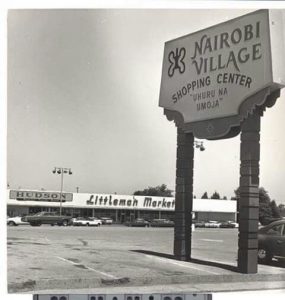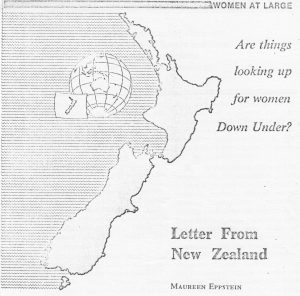Archive for September, 2018
The other side of the freeway
In the bottom drawer of my old black filing cabinet sits a battered cardboard box containing the manuscript of a novel I wrote in the early 1970s. I understand now why it never found a publisher. I was way too new to this country, and way too naïve, to do justice to its thorny subject: racial discrimination in housing. As I reread some of the text, I recalled the shock I felt when I first grasped the magnitude of the social gaps. The descriptions that follow come from my own experience as I researched the book, and it began my involvement with the fair housing movement.
Here is the central character Karen, a newspaper reporter, visiting the black ghetto of East Palo Alto for the first time to interview the director of a community advice center:
She knew vaguely that East Palo Alto belonged to the county. … She crossed the county line now, and accelerated to get onto the overpass that spanned the freeway. As she came down the ramp on the other side, she knew she was in a different country. The road was suddenly pot-holed and bumpy, and brown dust rose in thick choking swirls from its verges. She slowed, and looked about her. Such tiny bedraggled houses, desperately in need of paint. Yards littered with junk, yet here and there a brave attempt at order and color, a flower-bed, a well-cut lawn. She came upon a few tatty shops. Surely this couldn’t be the main shopping center? Yet soon she could see the sign, NAIROBI SHOPPING CENTER, and underneath, in a language she could not understand, UHURU NA UMOJA.
She had to force herself to open the door. Lurid accounts of rapes and muggings and violence in the streets flooded her mind. Here she was the enemy. She wanted to jump back into the car and get out, away from this place.
A woman passed, with two small children, headed for the market. She looked indifferently at Karen as she passed, then turned to scold one of the children, who was whining for candy. Karen let out the breath she had been involuntarily holding, and made herself move on. … Across the road, outside a liquor store, a black knot of middle-aged men stood transfixed in time, waiting for nothing.
It was hot. The dust lifted lazily as she walked. Something about the huge trees, and the stillness of the air, brought to her mind descriptions she had read of towns in the southern states. But this was California. It did not make sense. A mockingbird flashed its wings across her path, still proudly singing.
Karen does her interview, in which she learns about the pressures of living in East Palo Alto (and also finds herself attracted to Paul, the advice center director).
She said goodbye, and walked slowly back to the car, past the Louisiana Soul Food Kitchen and the Black and Tan Barber. The heat and dust were almost unbearable.
Back across the freeway, she noticed for the first time the neatly swinging redwood sign: Welcome to Palo Alto. A few blocks further down University Avenue and it hit her like a punch in the gut. She pulled over to the side of the road and rested her head on the steering wheel, fighting back an impulse to vomit. The contrast was an obscenity. Huge magnolias here lined the street on both sides, giving deep dappled shade to the well-paved highway. Between the road and the white concrete sidewalks rose great greening mounds of juniper and ivy, and beyond them, with manicured lawns and discreet sprinkler systems, were the complacent mansions of the rich.
Rumblings in the socialist paradise
I sold this early 1970s article about feminism in New Zealand to a US magazine. Unfortunately, the journal folded just after I’d received the galley proofs. Disappointing, but hey, these things happen. Reading the galleys again, I recognize many of my own frustrations, and understand a little better why I had to leave. I realize, of course, that New Zealand society today is very different from what it was then.
Letter From New Zealand
In New Zealand we say it is the land that shapes the people.
The land is lovely, but aloof; it has not welcomed intruders. For a few square miles the forest and scrub have given way, but the houses sit impermanent as boxes on the clearings, and in the towns the raw suburbs perch in self-conscious rows.
Europeans have been here for scarcely a hundred years. From the industrial ferment of 19th century Britain they brought a legacy of radical socialism, and from the obduracy of the land they grew a people that glorified the strong men, the rough, the plain-spoken, and left to its women the care of the arts and the domestic hearth. Together these two strands wove a welfare state that, in providing an economic floor beneath which no family can fall, has codified the disparities between the sexes, and underlined the definition of woman as housewife.
In the 1930s and ‘40s the pattern of social experiment these pioneers began reached its flowering in a social security system that offered a minimum wage, compulsory arbitration of wage disputes, pensions for invalids and deserted wives, family allowances that can be capitalized into housing down payments, low interest housing loans, low rent state houses, and a national health service that provides free medicines and medical treatment. A school dental service provides free dental care for all children. Most recently, in April 1974, an accident compensation scheme went into effect that covers everyone on New Zealand soil, whether earning money or not.
It is a complacently comfortable floor. But at its foundation is the assumption that the only proper place for a woman is in the home taking care of the children.
The welfare of the child is the prevailing argument. Says Norman King, New Zealand Minister of Social Welfare: “The majority feel that a close relationship with its own mother is the birthright of the New Zealand child. We do not want to encourage the adoption of a lifestyle in New Zealand where it becomes normal for the care of very young children to be a specialist task carried out by trained staff in group situations away from the family.”
New Zealand women achieved the right to vote in 1893, second only to Wyoming. Otago University in N.Z. admitted women to degree courses in 1871, the first in the British Empire. There are today very few women Members of Parliament, and no women at all in the administrative levels of higher education. Those who have reached positions of authority in any field are regarded as exceptions to the norm. And in a country as small as New Zealand, to be different is to be disapproved. A friend who returned home after ten years in London says: “Everything in New Zealand presses on me to settle down, to conform, to live safely, not to take risks.” My elder sister, Evelyn Stokes, has a doctorate in geography from an American university. Hostile vibrations still echo in our family over her decision to place her two children in a day care nursery so she could continue her university teaching.
Official thinking assumes that a mother who goes out to work does so either from economic necessity or from disproportionate greed. The idea that women might have talents other than domestic comes hard to New Zealanders. It is certainly not fostered by our education system, which from the start locks children into rigid sex role definitions.
From six-year-old Donald, Evelyn Stokes’s son, comes a crumpled school paper.
Check what toys girls like, he is instructed.
Big and little dolls? Yes, marks Donald. Correct, marks the teacher.
A train? No, marks Donald. Correct, marks the teacher.
A football? No, marks Donald. Correct, marks the teacher.
At the high school level the curriculum encourages vocational discrimination by sex: academic girls are steered towards the arts rather than the sciences, and average girls towards secretarial or home-craft courses.
But the winds of rebellion, fanned by global news services and travelers’ tales, are stirring the curtains at the kitchen windows. Women are staying at school longer and leaving with higher educational qualifications than ten years ago. The percentages of women and of married women in the work force are still lower than most western countries. But their numbers are increasing steadily, despite recent changes in the family benefit structure aimed at dissuading mothers from going out to work. Equal pay recently became law, and will be at least nominally applicable to all areas of the workforce by 1978.
Social custom compounds the problems of those married women who do go out to work.
Pat Brown has her own advertising agency. She told me that a company party with her husband, chief chemist at a freezing works, she attempted to discuss with his colleagues the implications of advertising and the sale of meat. Her husband’s boss took her firmly by the hand and led her to the far side of the room, where the other wives were discussing babies and knitting patterns. “This is your place,” he said.
Domestic duties are another stumbling block. Marriage counselor Marianne Thorpe says: “The difficulty is that women feel that they are responsible for the care of the home and children (and they get almost no help in this task), and this makes working outside the home a complicated business.” Evelyn Stokes and her husband Brian, head of math at a teachers’ college, share responsibility for housework and child care. It is an unusual set-up for a New Zealand family. More typical is Ray Lealand, now retired after a double career of clerical work and home-making, who says: “The most difficult problem I faced whilst working was non-cooperation from my husband.”
Role demarcation in some families is incredibly rigid. One friend recalls the raised eyebrows in her family when as a young bride she took on the vegetable garden. “That’s the husband’s job,” she was told. “The wife does the flowers.”
Since most women expect to stay home once they have a child, the idea of maternity leave is not widely accepted. When Evelyn Stokes applied for leave for the birth of her second child, the committee set up to look into the matter came back with a regulation that a mother who applies for maternity leave “is required to satisfy the university that her additional family duties are compatible with the continuation of her employment.”
Child care facilities for working mothers are inadequate, and though support for day care centers was a major plank in the ruling Labour Party’s 1972 election platform, its implementation has been whittled down to a subsidy to needy children in existing voluntary centers. Part-time employment coinciding with school hours is widely accepted, but employers will take on mothers of preschoolers only as a last resort, and use the argument of family responsibilities to pin women to the lower scale, “temporary” job classifications.
Sex role definitions still apply in employment. Six occupation groups employ 65% of New Zealand’s working women: clerical, sales, clothing manufacture, teaching, nursing, and domestic service. But there has been some movement into the traditionally male areas of drafting, electronics, and electrical work, and into the newer technological jobs like computer programming or systems analysis, where sex-exclusive traditions have not yet calcified. With a shortage of male labor in many fields, a few pioneers are braving the public ridicule and breaking down job opportunity barriers. One such incident, in 1972, even rated media coverage. Two girls applied for jobs in an Auckland factory as aluminum glaziers, only to be told this was not a woman’s job. When they asked “Why not?’ no answer could be found, and they were taken on.
This thread of social change is closely woven with another that is a constant in New Zealand life. Few in numbers, and isolated by thousands of miles from the sources of our culture, we have been almost pathologically dependent on the word from the outside world. I remember my first beat as a cub reporter; I scurried round the tourist hotels of Christchurch, winkling out startled visitors and begging them to express an opinion. Any opinion. Still the pattern continues. Articulate voices from abroad, no matter what their status, receive far more attention than local expects on the same subject.
The feminist movement is a case in point. Local groups springing up in the past few years have found a climate of hostility and ridicule. The ideas of American feminists, distorted by distance and by different cultural norms, have seemed to many to be irrelevant to the New Zealand experience. Then early in 1973 two visitors coincided: Evelyn Reed, an American Marxist feminist who advocated abortion law reform and improved child care facilities, and Dr. John Bowlby, a British psychiatrist know for his work on the deleterious effects of maternal deprivation on a child’s mental health. Both, basking in the aura of the magic words “from overseas,” were taken seriously by the local press. Margot Roth, editor of the Journal of the N.Z. Society for Research on Women, comments that the resulting controversy opened up a much wider range than usual of questions concerning women, and helped lay the foundation for the success of a United Women’s Convention held September 1973 in Auckland to mark the 80th anniversary of women’s suffrage.
The purpose of the convention, according to the organizers, was to correct the distorted view New Zealand women had of modern feminism, to raise the status and self-confidence of women, and to increase the numbers of women willing to work on behalf of women’s issues.
Statistics indicate that the fifteen hundred women who attended, while better educated and more likely to be employed than the average, nevertheless made up a remarkably accurate cross-section of New Zealand society. The issues discussed were those that concern women everywhere: job opportunities, control of their bodies, marriage and child care, sex stereotyping.
Press reportage of the Convention again sought to trivialize and ridicule. Afternoon TV revealed to local mums some of the hogwash poured down the verbal ducts at the United Women’s Convention, reported one city daily.
However, rage over press flippancy reinforced a feeling of unity at the conference, and the consensus of those who attended is that, for the first time, women from the whole range of backgrounds and interests in New Zealand life experienced a feeling of sisterhood.
The floodgates are open. Women with common interests are pooling resources. The prestigious National Council of Women, umbrella for all women’s organizations in New Zealand, and for long a stronghold of the traditional view, is now espousing the cause of equality and encouraging its affiliated groups to contribute.
It is hard to say what the future will hold. Though New Zealanders travel the world as casually as migrating godwits, jet planes cannot eliminate the sense of lonely isolation that makes us belittle our homegrown prophets. The land still broods, raw, stubborn, and the people it has bred still revere the sheep shearer above the artist. On embroidered tablecloths, housewives still set teas of cream cakes and scones, and rows of preserves still gleam on pantry shelves.
But the women of New Zealand have a stubborn streak too. Diffident, shy, self-conscious in proclaiming the ideas that come from an almost alien American culture, we are nevertheless gathering strength. The spirit that made New Zealand one of the most comfortable societies in the world may yet take a mattock to the scrublands of tradition, and graze the new fields of equality.


